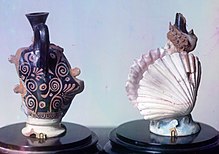Ancient history
Trade is believed to have taken place throughout much of recorded human history. There is evidence of the exchange of obsidian and flint during the stone age. Trade in obsidian is believed to have taken place in Guinea from 17,000 BCE.[12][13]
The earliest use of obsidian in the Near East dates to the Lower and Middle paleolithic.[14]
— HIH Prince Mikasa no Miya Takahito
Trade in the stone age was investigated by Robert Carr Bosanquet in excavations of 1901.[15][16] Trade is believed to have first begun in south west Asia.[17][18]
Archaeological evidence of obsidian use provides data on how this material was increasingly the preferred choice rather than chert from the late Mesolithic to Neolithic, requiring exchange as deposits of obsidian are rare in the Mediterranean region.[19][20][21]
Obsidian is thought to have provided the material to make cutting utensils or tools, although since other more easily obtainable materials were available, use was found exclusive to the higher status of the tribe using "the rich man's flint".[17]
Obsidian was traded at distances of 900 kilometres within the Mediterranean region.[22]
Trade in the Mediterranean during the Neolithic of Europe was greatest in this material.[19][23] Networks were in existence at around 12,000 BCE[24] Anatolia was the source primarily for trade with the Levant, Iran and Egypt according to Zarins study of 1990.[25][26][27] Melos and Lipari sources produced among the most widespread trading in the Mediterranean region as known to archaeology.[28]
The Sari-i-Sang mine in the mountains of Afghanistan was the largest source for trade of lapis lazuli.[29][30] The material was most largely traded during the Kassite period of Babylonia beginning 1595 BCE.[31][32]
Ancient Etruscan "aryballoi" terracota vessels unearthed in the 1860s at Bolzhaya Bliznitsa tumulus near Phanagoria, South Russia (then part of the Bosporan Kingdom of Cimmerian Bosporus); on exhibit at the Hermitage Museum in Saint Petersburg.
